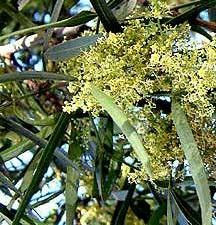African sumac
(Searsia dregeana)

Description
Searsia lancea commonly known as karee (Syn. Rhus lancea) is an evergreen, frost hardy, drought resistant tree, which can reach up to 8 metres in height with a 5-metre spread. In North America, where it is naturalized, it is known as African sumac and willow rhus. It is one of the most common trees on the Highveld and in the Bushveld in South Africa, but not found in the Lowveld. The tree is dioecious. It has a graceful, weeping form and dark, fissured bark that contrasts well with its long, thinnish, hairless, dark-green, trifoliate leaves with smooth margins. It bears small yellow flowers followed on female trees by bunches of small yellow-green flattish fruits, which are relished by birds. In earlier times the fruits were pounded, water added and left to ferment, producing an evidently refreshing beer. The tree is a good shade tree for gardens, parks and pavements. It favours areas rich in lime in the Karoo and Namibia. Sumac is any of about 35 species of flowering plants in the genus Rhus and related genera in the cashew family (Anacardiaceae). Sumacs grow in subtropical and temperate regions throughout the world, including East Asia, Africa, and North America. Sumac is used as a spice, as a dye, and in medicine. Sumacs are dioecious shrubs and small trees in the family Anacardiaceae that can reach a height of one to ten metres (3–33 ft). The leaves are usually pinnately compound, though some species have trifoliate or simple leaves. The flowers are in dense panicles or spikes 5–30 cm (2–12 in) long, each flower very small, greenish, creamy white or red, with five petals. The fruits are reddish, thin-fleshed drupes covered in varying levels of hairs at maturity and form dense clusters at branch tips, sometimes called sumac bobs. Sumacs propagate both by seed (spread by birds and other animals through their droppings), and by new shoots from rhizomes, forming large clonal colonies. The taxonomy of Rhus has a long history, with de Candolle proposing a subgeneric classification with 5 sections in 1825. At its largest circumscription, Rhus, with over 250 species, has been the largest genus in the family Anacardiaceae.
Taxonomic tree:







